At The Study Academy, we’re often acquainting ourselves with recent research on effective teaching strategies and structures of learning. In a recent search, we encountered an article on the website of the American Psychological Association entitled, “Top Twenty Principles From Psychology for PreK-12 Teaching and Learning” (which you can access directly here). After reading through the enclosed principles, I recognized that many of them were already underlying the framework of instruction that I’ve both witnessed and undertaken at The Study Academy. Since that’s the case, and since readers can have a glance at the principles themselves, what I’ve written below is not a summary of all 20 of the key principles outlined in the article, but instead, my own thoughts and relationship to 4 of those principles, both as an instructor and a learner.
What I quickly realized while writing was that I was gravitating toward principles that had a lot to do with personal responsibility. I think this has to do with my own personal optimism about the competency of students and the value of autonomy, but it perhaps equally has to do with the student-centred nature of instruction of The Study Academy.
So, in glorious non-chronological order, here are my thoughts:
As we are already well into the academic year, students are facing numerous types of deadlines. Deadlines are, of course, inevitable and necessary fixtures of academic proceedings. If heeded with the proper care, deadlines can incentivize students to develop crucial organizational skills that possess lifelong applicability. And yet, we all know that any kind of project quickly becomes dreary when the looming spectre of a deadline forms the sole motivation for academic progress. We know intuitively that curiosity and innovation resides in domains beyond the fear of a deadline. The ninth principle illuminates why this is the case: “students tend to enjoy learning and to do better when they are more intrinsically rather than extrinsically motivated to achieve.” The article refers to deadlines and reward systems (such as the approval of teachers and parents) as examples of extrinsic motivators. The approval of others is certainly not a bad thing in itself, but it does appear that over-reliance on it may not be the most promising enterprise. While intrinsic motivation can come in various forms, researchers say that a really important core belief to achieve it is through the understanding that learning is inherently valuable — this, the authors assert, is one major way students come to progress for their own sake. And since extrinsic conditions are unstable and impermanent, the quest for intrinsic motivation makes for a more resilient position.
So, how do we accomplish this as teachers? In my own experience in this role, I encourage autonomy through classroom discussion and debate. I always strive for a mix of designing discussion topics and allowing students to do so. In my undergraduate degree, I had an English professor who said, “Texts won’t give you answers to questions you don’t ask.” That remark made an instant impression on me. I figured since it wouldn’t be possible for me to predict the questions an instructor expected me to ask, I would necessarily be engaging in a unique and radically individual exercise by posing questions of my own devising. And certainly, as I kept asking the text questions, the more personally relevant my questions became. They became so relevant, in fact, that it felt like I was working beyond the parameters of a single assignment. Thus, when I instruct English courses now, I always put emphasis on open dialogue and reflection, and remind students of the infinity of questions they can ask. My rationale is that if they are able to strike upon an interplay of personal reference points and the work at hand, this constructs a sturdy bridge to a wealth of intrinsic motivation. Furthermore, the meaning of the work has ripple effects far outside the bounds of the particular assignment, and therefore we are not dealing only with extrinsic motivations anymore.
Of course, knowledge acquisition is not limited to gaining entirely new information; it is also about challenging and, if necessary, reshaping previous assumptions and hypotheses. Principle 2 of the article speaks to this by distinguishing between conceptual growth (gaining new information) and conceptual change (reforming old assumptions). The first stage for teachers when exploring new subject matter is to gauge which strategy needs to be employed. Lessons and evaluations provide instructors the chance to gauge the baseline level of understanding. According to the article, if the baseline understanding is in line with curricular expectations, then instructors can plan their exercises in a way that fosters conceptual growth. However, when an instructor encounters a student working under an apparent misconception, instead of simply trying to change that “wrong thinking” on the spot, the instructor might rather set the stage for that student to self-correct. A student is only able to do that, though, if he or she has the space to try and advance their idea to a deeper stage of critical investigation. A tactic I use when I lead class discussions is in a sense echoing responses back to students. If I am able to maintain a non-judgemental yet skeptical tone, it opens up room for what in some cases may be very productive doubt. Moreover, having their ideas voiced by another person can be a way to help students gain critical distance from which vantage point they can either defend, revise, or outrightly change their assertions.
Keeping with the theme of personal responsibility, Principle 7 emphasizes the importance of self-regulation, which includes a broad range of capacities needed for academic success, including attention and self-control. The article stresses that teachers can help students improve these crucial abilities. We agree, and that’s evident through our curricular offerings and daily schedules. Students practice self-regulation everyday through meditation. We organize it so that students engage in the practice in a group, but with total autonomy and control over their experience. Since the only rules are that students sit in a comfortable position in silence, we avoid imposing rigid methodology onto how they self-regulate. Students who use the brain technology games we offer have a similar level of personal freedom while honing their focus. Additionally, the Learning Strategies course can also be a great way for students to work on organizational skills needed to stay on top of course work.
Another way to think about the Learning Strategies course is as an opportunity to transfer skills. Students may learn strategies geared toward building links between separate ideas. That way, in science, they are likely to forge the connection between algae growth and aquatic ecosystems, for example. Another way to think about this academic process is through Principle 4’s discussion of contexts. The authors clarify, first of all, that all learning does in fact occur in particular contexts, and that “generalizing learning to new contexts is not spontaneous but needs to be facilitated”.
One basic question we might ask upon reading this principle is the following: What are some examples of different contexts? Another question may come about when we pay further attention to the language of the principle. How can we as educators “facilitate” both context traversal and the application of ideas from one context to another?
Let’s take one context shift that the article mentions for example: students can take textbook knowledge and see how the ideas actually operate with and animate physical environments. I now realize that this is why I was so intuitively eager to write on the annual Brain Camp (you can access the entry here) event last year. This was an end-of-year event during which students stepped into a diverse set of contexts. They took part in outdoor activities, creative projects, attended various cultural sites, and more. On a broad level, the organization of these multifarious events was the facilitation for students to engage with different contexts. For instance, science experiments gave students the chance to enter a socially interactive and highly sensory context, in contrast to the text-based study of scientific formulas and principles. Or, when students worked on film-making, they entered a context of application for which all their instruction on narrative elements came in handy. One of the substantial boons of these new levels of engagements are that they necessitate mental activity beyond the surface level. Instead of rote memorization, students considering an impressionist painting at the Art Gallery of Ontario must draw from deeper wells of curiosity and critical thinking.
And certainly, students are encouraged to jump between contexts in creative and new ways. After all, Principle 4 is all about frame-breaking and “thinking outside the box”. So, for instance, during Brain Camp when they were asked to cook (or for the assertive students who cook at home), the students might stop and think about the ways in which kitchen utensils are made with materials that optimize heat conductivity for the purpose of cooking, while stifling the distribution of heat along the handles for the purposes of safety. Such an act of application takes conductivity from the subject-specific domain of science and applies it to real life tasks and tools.
Ultimately, the article from the APA strikes me as having the potential to be incredibly useful for students, their parents, and instructors. It includes practical tips for achieving academic objectives and explains why those objectives are worthwhile. While I hope my own thoughts in this piece have made for an interesting read, I strongly encourage readers to peruse the source material, as I’ve referred to a mere fraction of what’s included in it. Happy reading!

